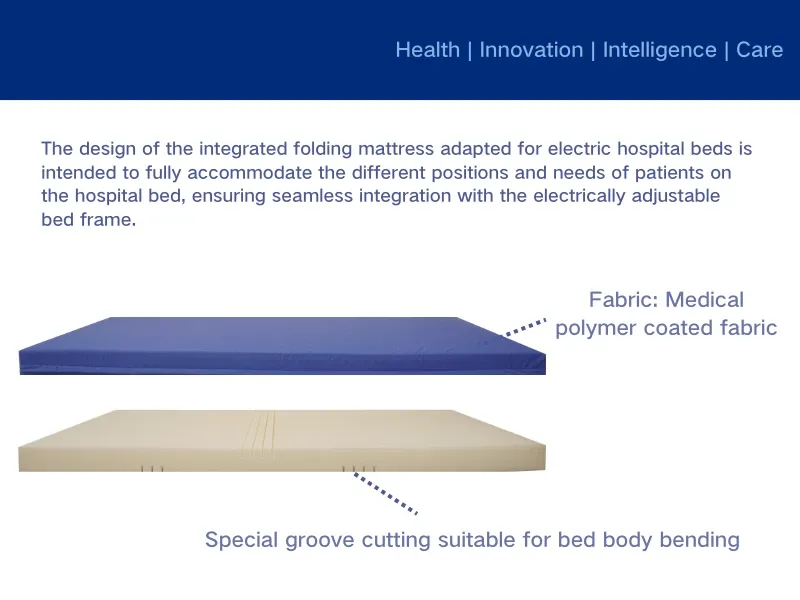The Role of Wave Mattress Systems in Pressure Ulcer Prevention
Pressure ulcers, also known as bedsores, are a significant concern in healthcare settings, particularly for patients with limited mobility. These painful and potentially dangerous wounds develop due to prolonged pressure on specific areas of the body, reducing blood flow and causing tissue damage. One of the most effective solutions for preventing pressure ulcers is the use of specialized support surfaces, such as wave hybrid mattress, and wave foam mattress. These innovative systems distribute pressure evenly, enhance airflow, and provide dynamic support to reduce the risk of tissue breakdown.

Wave Mattress: Understanding Pressure Ulcers and the Need for Advanced Support Surfaces
Pressure ulcers typically form on bony prominences such as the heels, hips, sacrum, and shoulders. Patients who are bedridden, wheelchair-bound, or have limited mobility are at the highest risk. Traditional mattresses often fail to provide adequate pressure redistribution, leading to localized stress on vulnerable areas.
This is where the wave mattress comes into play. Unlike conventional flat surfaces, wave foam mattress and wave hybrid mattress designs incorporate unique wave-like patterns or alternating pressure zones that help minimize sustained pressure points. By continuously adjusting support, these mattresses prevent prolonged compression on any single area, significantly lowering the risk of ulcer formation.
How The Wave Hybrid Mattress Combines Support and Comfort
The wave hybrid mattress is a sophisticated solution that merges different materials to optimize pressure relief. Typically, it combines memory foam, latex, or gel-infused layers with an innerspring or air-based system. This hybrid approach ensures both responsiveness and adaptability, catering to patients with varying weight distributions and medical needs.
One of the key advantages of the wave hybrid mattress is its ability to conform to the body while maintaining structural support. The wave-like surface design enhances airflow, reducing heat buildup—a common issue with standard hospital mattresses that can exacerbate skin breakdown. Additionally, the hybrid construction allows for targeted pressure relief, making it ideal for high-risk patients in long-term care facilities.
Wave Foam Mattress: Enhanced Pressure Redistribution for At-Risk Patients
For patients who require a softer yet supportive surface, the wave foam mattress offers an excellent alternative. Made from high-density viscoelastic foam, this mattress type molds to the body’s shape, dispersing pressure more effectively than traditional flat foam mattresses.
The "wave" pattern in the wave foam mattress is not merely aesthetic—it serves a critical function. The peaks and troughs create micro-movements as the patient shifts, preventing stagnation in any single pressure point. Furthermore, the open-cell structure of medical-grade foam enhances breathability, reducing moisture accumulation that can weaken skin integrity.
Studies have shown that wave foam mattresses significantly reduce the incidence of pressure ulcers in clinical settings, particularly when used proactively rather than reactively. By integrating these mattresses into standard care protocols, healthcare providers can improve patient outcomes and reduce treatment costs associated with advanced wound care.
The Wave Mattress in Clinical and Home Care Settings
While the wave hybrid mattress and wave foam mattress are commonly used in hospitals and nursing homes, the wave mattress is also gaining popularity in home care. Patients recovering from surgery or managing chronic conditions such as paralysis can benefit from these specialized support surfaces.
Home-use versions of the wave mattress often feature adjustable firmness settings, allowing caregivers to customize support based on the patient’s needs. Some models even incorporate low-voltage alternating pressure systems, further enhancing ulcer prevention for high-risk individuals. The portability and ease of maintenance make the wave mattress a practical choice for long-term home care.
The Science Behind The Wave Hybrid Mattress and Wave Foam Mattress
The effectiveness of the wave hybrid mattress and wave foam mattress lies in their biomechanical design. Research indicates that alternating pressure and consistent offloading are crucial in preventing tissue ischemia (lack of blood flow). The undulating surface of the wave mattress ensures that no single body part bears excessive weight for extended periods.
Additionally, advanced materials used in the wave hybrid mattress, such as temperature-regulating gels and antimicrobial fabrics, contribute to skin health by maintaining an optimal sleep environment. These features are particularly beneficial for patients with diabetes or circulatory disorders, who are more susceptible to pressure-related injuries.
The Future of Pressure Ulcer Prevention with The Wave Mattress
As medical technology advances wave hybrid mattress, and wave foam mattress continue to evolve, offering even greater protection against pressure ulcers. These systems represent a proactive approach to patient care, reducing the physical and financial burdens associated with chronic wound management.
Healthcare providers should consider integrating the wave hybrid mattress or wave foam mattress into standard care plans for at-risk patients. By doing so, they can enhance comfort, improve circulation, and ultimately prevent the development of painful and costly pressure ulcers.
In both clinical and home settings, the wave mattress stands as a vital tool in the fight against bedsores, ensuring better quality of life for patients and peace of mind for caregivers.
-
The Science Behind Silicon Mattresses for Critical Care EnvironmentsNūhouJul.16,2025
-
The Role of ICU Nursing Silicon Mattress in Preventing Pressure UlcersNūhouJul.16,2025
-
Long-Term Bedridden Patients and the Advantages of Silicon Mattresses in the ICUNūhouJul.16,2025
-
From ICU to Home Care: Expanding the Use of Silicon Mattresses for Nursing NeedsNūhouJul.16,2025
-
Choosing the Right Wave Mattress for Different Levels of Patient CareNūhouJul.16,2025
-
The Effect of Coconut Foam Mattress Breathability and Humidity Regulation on Improving Sleep QualityNūhouJul.03,2025
-
How Wave Mattress Systems Improve Blood Circulation During ImmobilityNūhouJul.03,2025

